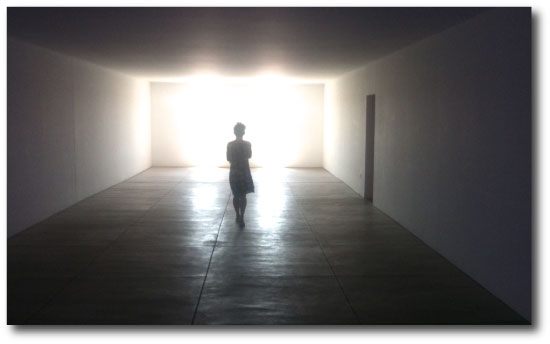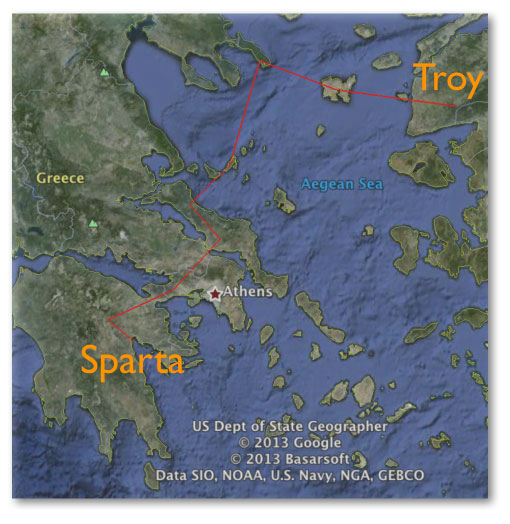The amount of information that can be carried on a laser diode-driven fiber optic cable is staggering. The current state-of-the-art is of order a petabit per second over 50 km, with a direct power consumption of order 100 milliwatts, as described in this press release from NTT, and in primers on optical communication.
When data is transmitted via optical fiber, no signal leaks into space at all (other than a trivial quantity of waste heat). From the standpoint of eavesdropping civilizations, Earth is going dark, presenting a fashionable and much-remarked potential solution to the Fermi Paradox.
To order of magnitude, fiber optic cables currently employ 10^-16 ergs to transmit one bit of information over a distance of one centimeter. It’s interesting to compare this with the energy throughput and transmission efficiency of the first recorded description of an optical information transmission network.
In The Information — A History A Theory A Flood, James Gleick draws attention to a passage that appears in Aeschylus’ Agammemon describing how a chain of eight signal bonfires transmitted the news of Trojan defeat over the course of a single night to Clytemnestra, scheming, four hundred miles away in Sparta.
Aeschylus’ full passage is worth tracking down and is thrilling to read; a satisfyingly direct antecedent to NTT’s press release describing their record-setting petabyte per second optical data transmissions.
LEADER:
Yet who so swift could speed the message here?
CLYTEMNESTRA:
From Ida’s top Hephaestus, lord of fire,
Sent forth his sign; and on, and ever on,
Beacon to beacon sped the courier-flame.
From Ida to the crag, that Hermes loves,
Of Lemnos; thence unto the steep sublime
Of Athos, throne of Zeus, the broad blaze flared.
Thence, raised aloft to shoot across the sea,
The moving light, rejoicing in its strength,
Sped from the pyre of pine, and urged its way,
In golden glory, like some strange new sun,
Onward, and reached Macistus’ watching heights.
There, with no dull delay nor heedless sleep,
The watcher sped the tidings on in turn,
Until the guard upon Messapius’ peak
Saw the far flame gleam on Euripus’ tide,
And from the high-piled heap of withered furze
Lit the new sign and bade the message on.
Then the strong light, far-flown and yet undimmed,
Shot thro’ the sky above Asopus’ plain,
Bright as the moon, and on Cithaeron’s crag
Aroused another watch of flying fire.
And there the sentinels no whit disowned,
But sent redoubled on, the hest of flame
Swift shot the light, above Gorgopis’ bay,
To Aegiplanctus’ mount, and bade the peak
Fail not the onward ordinance of fire.
And like a long beard streaming in the wind,
Full-fed with fuel, roared and rose the blaze,
And onward flaring, gleamed above the cape,
Beneath which shimmers the Saronic bay,
And thence leapt light unto Arachne’s peak,
The mountain watch that looks upon our town.
Thence to th’ Atreides’ roof-in lineage fair,
A bright posterity of Ida’s fire.
So sped from stage to stage, fulfilled in turn,
Flame after flame, along the course ordained,
And lo! the last to speed upon its way
Sights the end first, and glows unto the goal.
And Troy is ta’en, and by this sign my lord
Tells me the tale, and ye have learned my word.
Given that the message was one bit, the signal coding was at the Shannon Limit. The route can be correlated with current-day geographic features,
and then traced out in Google Earth:
The bonfire on Mt. Ida that signaled the end of the Trojan War probably consumed about a cord (3.62 cubic meters) of wood and emitted about 5×10^12 ergs/sec over a span of an hour, for a transmission efficiency of order 10^9 ergs per centimeter per bit. A mere three thousand years has brought twenty five orders of magnitude of improvement.
With the take-away being that the quality of the message is likely superior in importance to the quantity.




Great article — I love the combination of technology and history. Many thanks for this!
Very nice!